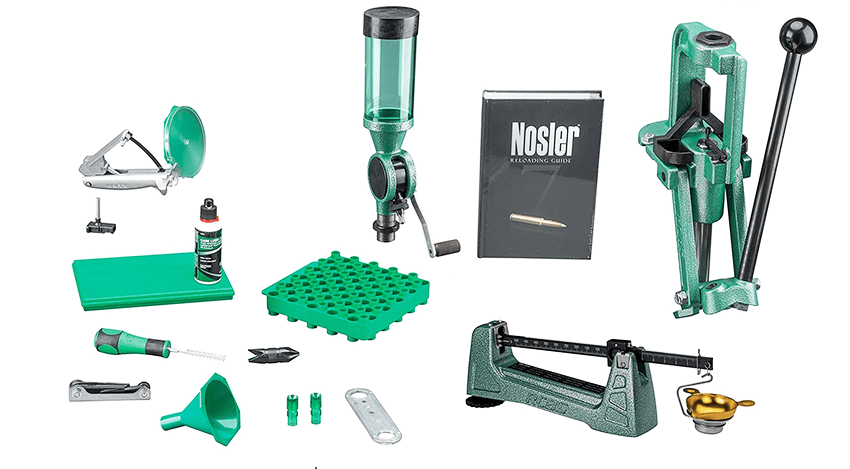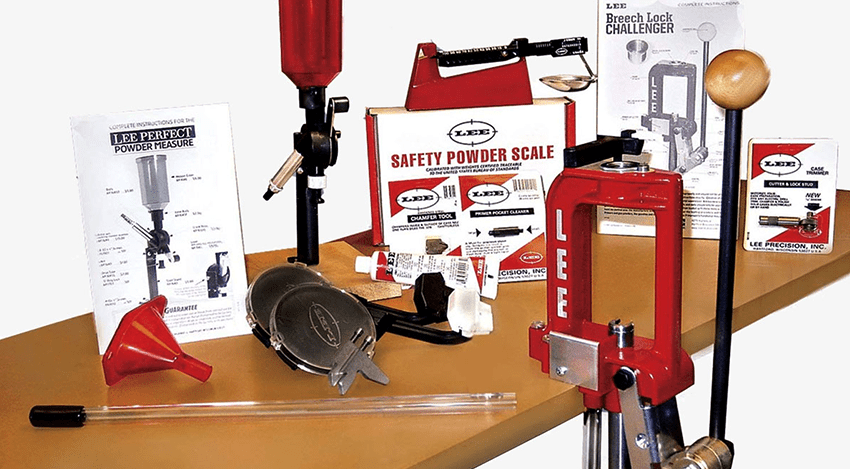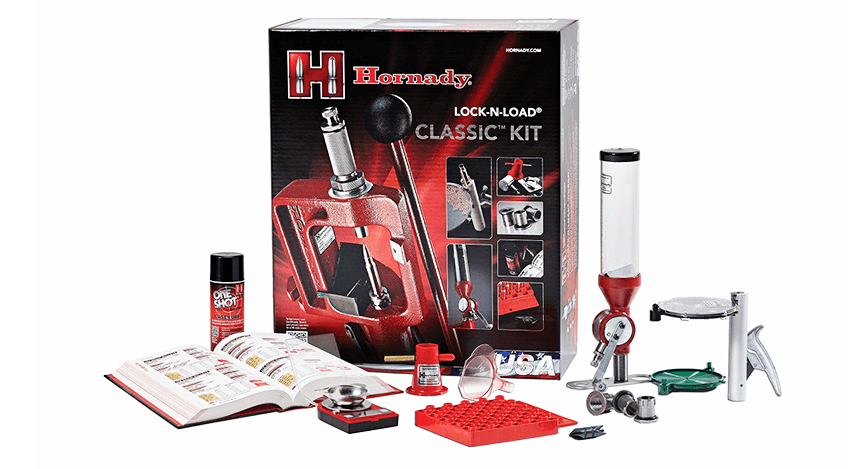 Back to News
Back to News
December 9, 2020
Selling It—Reloading Equipment #2, By/Buy the Bundle
I know someone who wanted to start reloading 9mm rounds. This was before small pistol primers started being sold in dime-bags for a buck a piece, back when they were plentiful and cheap. My friend was determined to figure out his own reloading setup and buy everything himself at the best prices he could find.
He eventually got his bench set up, but just when he was about to make his first batch of 9mms, he realized he’d forgotten to buy any kind of tool to weigh his powder charges. He’d purchased a powder measure but failed to buy a scale so that he could adjust his press to throw the charge he needed. That was enough to deflate him completely. He actually boxed everything up, returned it and gave me the primers and powder he’d bought, which is when he told me what he’d done.
“Why didn’t you just ask me, man?” I asked him.
“Ah, I wanted to figure it out for myself. I guess I’m just not detail-oriented enough for it.”
I think he was just embarrassed to ask and admit he didn’t fully understand the process behind what he was about to attempt, and that’s no way to be. Nobody knows everything when they’re starting out, and most know nothing.
The Fear Factor
In my last “Selling It” column, I talked about using a demo model to help walk your customer through the steps of the reloading process. But there’s more to selling reloading equipment than the gear itself.
To the customer on the opposite side of the counter from you, reloading is a scary thing to get into if they’ve never done it before. It just is. It can actually be far more intimidating than buying a firearm for the first time, and the array of components and tools and load-data tables are enough to make a whole lot of customers just slowly back away and say to themselves, “Yeah, I’ll just keep looking for good deals on budget ammo, when that’s a thing again.” Add in the fear of making a mistake that could result in a blown-up gun or serious injury, and the barrier to entry for ammunition reloading is quite high.

The good news for your customer today, even with the current scarcity and consequential rising expense of reloading components like powder and primers, is that we’re not looking to pursue reloading in the 1950s, ’60s and even ’70s. Back then, much of the information reloaders needed was locked away in sometimes hard-to-find manuals full of tiny print and tables, not to mention in the minds of people who kept their reloading knowledge and recipes close secrets. Today, there’s oodles of information about load data and even load-data calculators just a Google search away, and you can find any reloading manual you desire with a couple clicks. The internet’s vast repertoire of reloading tips and instructions for pretty much any kind of cartridge or shotshell somebody might want to put together are, likewise, just clicks away, and, if for some reason you can’t find what you need to know that way, there are lots of forums, subreddits and other online communities where questions can be posed and you can, in turn, receive, usually sensible answers.
All that helps. A lot. But even though the necessary information is readily accessible by anyone, when it comes time to plunking down the money for a reloading setup, those other intimidating barriers are still there.
Managing Expectations
When I first began reloading, it was with a humble Lee Loader, a rubber mallet and forgiving .45 ACP rounds. I used the Lee dipper measure that came with the kit after looking up the load data for the Winchester Autocomp I’d bought and seeing that the amount the dipper held was just right. But guess what? While I’d kept my setup super simple, I still didn’t have everything I needed off the bat.

When I realized I had to use a hammer to prime the cartridges with the Lee Loader, that honestly freaked me out a little, and I opted to order a simple case-priming tool, which put my first reloading session on hold for a few days. I also didn’t have calipers to measure the overall length of my finished cartridges, so that was another delay.
It’s almost a guarantee that your store’s salespeople who reload had similar shortcomings when they first started. The problem, now, is that they’ve forgotten they ever had those problems. So, like I said in the last column, your sales staff need to take two steps back and really think through each step of the reloading process so that they can manage their customers’ expectations—and prevent that six-box return of product they can’t figure out.
Once you’ve had the serious part of the conversation with your customers about safety precautions and gotten them backed away from the cliff of “I can’t possibly do this without blowing up my gun!” your next step in managing their expectations is to help them understand, right from the get-go, that reloading is one of those things where you’re never really done buying stuff. If you see your customer balk at that idea, be prepared to remind them that all shooting requires repeat purchases when it comes to ammunition, this is just about rolling your own instead of purchasing it whole. With reloading, and even if you acquire every single tool you want and never need to try anything else, you still have to buy bullets, primers and powder regularly, and that’s if you only use fired brass. Now’s the time to stress that, when the world rights itself and returns to normal, all those repeat purchases for powder, primer, etc., will be no less a regular part of their days at the range or in your store than their buying of factory ammunition and it will, in fact, be cheaper.
With your customer still on board and, hopefully, actually excited about the prospects of making their own ammo, the sooner they can crank out a batch of complete cartridges and shoot them, the sooner they’ll be a dedicated reloader. The companies that make reloading tools know this, and that’s why pretty much all of them offer reloading kits. They’re available at varying price points, usually based on the press that’s included, with everything somebody needs to get started all in one box. Usually, the presses included in these kits are a company’s tier-one or tier-two models. The idea, with these ready-to-go kits, is that they satisfy that immediate need to get started successfully. That in turn builds confidence and, eventually, allows you and them to upgrade to a higher-end progressive press.
A Kit All Your Own—And Better for Your Clients
But, first things first and back to the kits. Of course, all the components in these kits are usually made by the same company. That’s fine, but no kit is a one-size-fits-all, and each brand does things better and worse than other brands.
So, how can retailers help customers get exactly what they need without overpaying or acquiring stuff they don’t need and that may overcomplicate the reloading process for them? Make up your own reloading kits for your customers based on what they want to do and with the best components for the price.

You can do this on a customer-by-customer basis or pick a few common calibers. Especially with the latter, when that customer who bought a SIG P365 from you a couple months ago comes in asking about rolling their own ammo, you can present your pre-assembled 9mm “beginner reloader’s bundle”—including bullets, brass, powder, and primers—and make it really easy for them.
With any store-assembled kit, be sure you and your sales staff have used it, can attest to the quality of the components included in your bundles and explain how every one of them works. But then go a step further, using the demo example from the last column as a foundation. If you have a lot of people coming in who are, say, making their own .308s, set up a basic reloading station for .308 so you can walk newbies through the process and show them why each tool you’ve included in your bundle is needed, what it does and how it does it. Nothing builds confidence like seeing someone do it in person, and you can add real value to the process by recording your demonstration and emailing your customers a link to the video to use as a reference after they’ve bought a reloading bundle.
Now, if only someone had done that with my first go at reloading .45 ACP …
You may also be interested in:
https://www.nssf.org/selling-it-reloading-equipment-part-1/
https://www.nssf.org/personal-defense-ammo-considerations/
Categories: BP Item, Featured, Retailers, Top Stories









